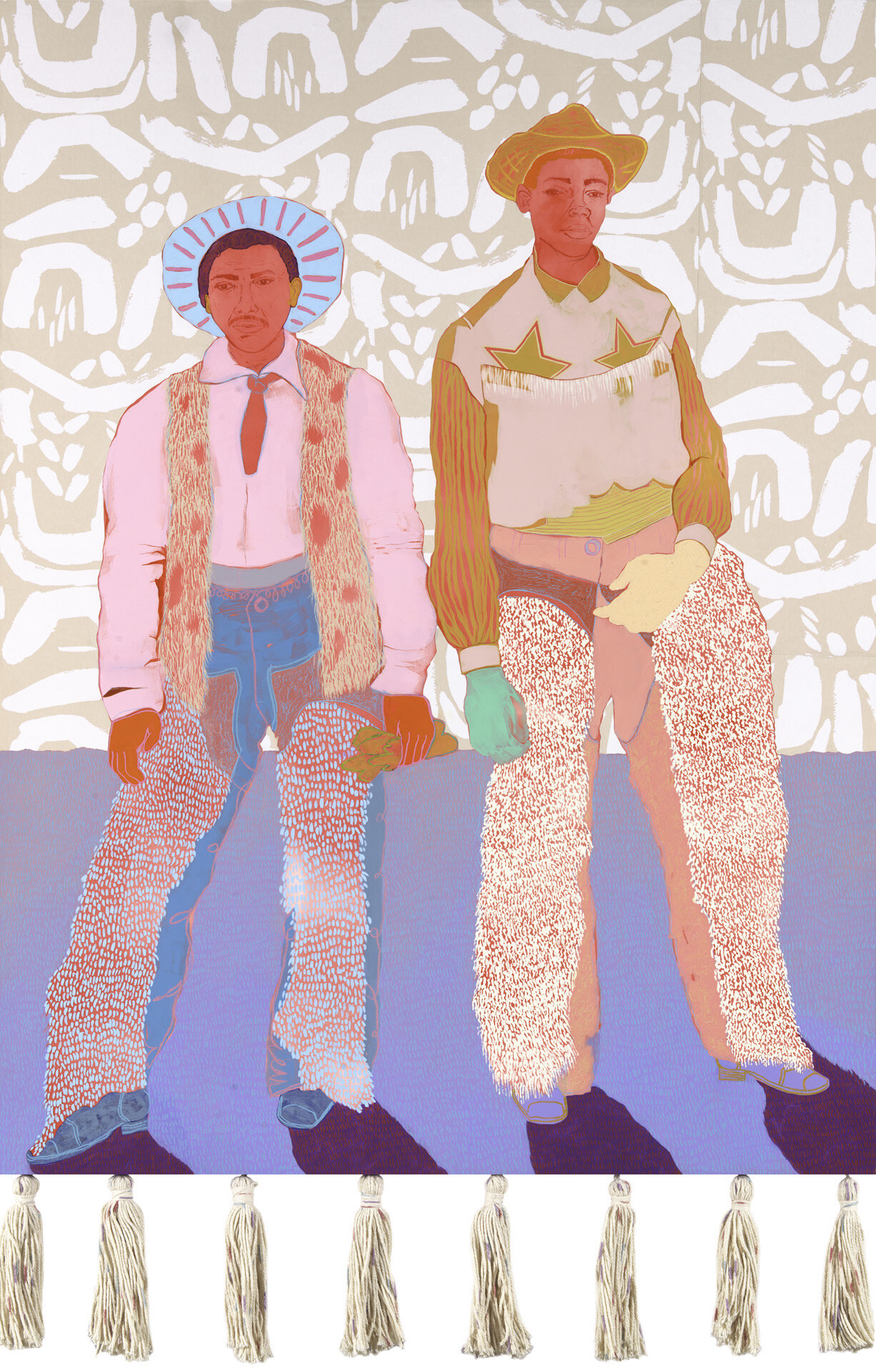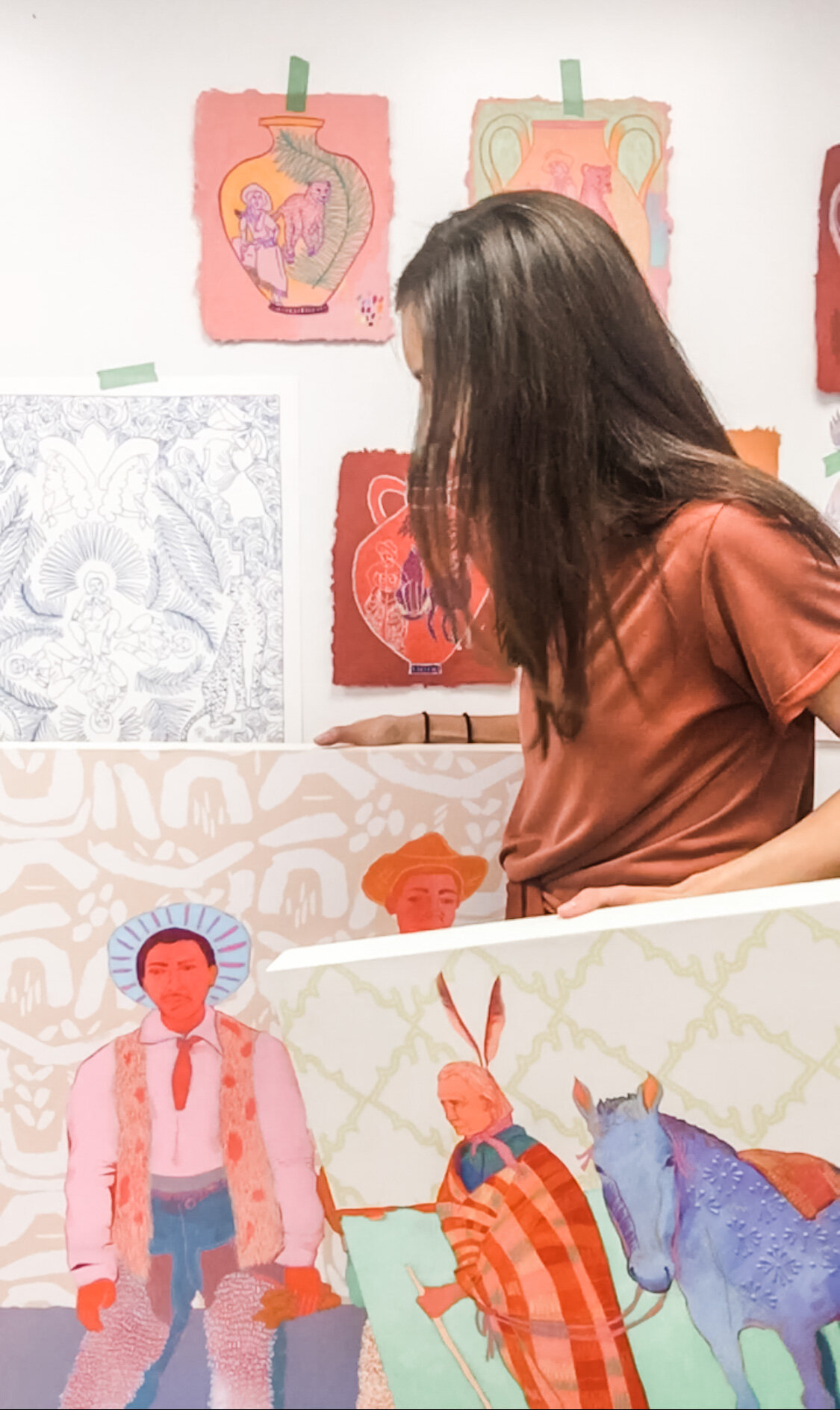1. Describe your experience of professional training and how does it continue to inform your process and productivity?
After obtaining my BFA, I went on to receive my MA and MFA training in both drawing and painting. Having this experience completely changed the trajectory of my career, as I was taught how to create and interact with artwork on a much deeper level. In undergraduate school, 4 years is too short of a time to become acquainted with all the various art media and declare a specialty. So, my MA and my MFA were about digging deeper into the boundaries of paint, intersectionality of paint and other media, and the fluency of art as a language. The 8 years of this education is irreplaceable and I bring this growth with me to the studio every day. It’s how I think.
2. What is your average day like both in the studio and out and about?
Well, COVID has certainly turned my average day in the studio on its head. I became a mother in 2019, but didn’t feel a balance between my roles until 2020 when I took an “artist by day, mother by night” approach thanks to daycare. However, now it’s the opposite. I recognize that her age and this moment in history is fleeting, so it feels right to be “all in” during my day with her. I use nap times for administrative tasks. At 8pm, when she is down for the night, I make a cup of coffee and head to my basement studio where I work until midnight. Knowing that I have solid, uninterrupted time ahead of me allows my brain and energy to settle and delve deep into the flow.
3. How has being shortlisted for the Young Masters Art Prize in 2019 as well as being exhibited in London impacted you and your career?
The experience still brings a smile to my face. Being shortlisted for the Prize and exhibiting in London were career milestones for me. It was the first time I was shortlisted for a prize, the first time I had exhibited in London, and subsequently the first time I exhibited (and sold) at a fair when the work travelled to the London Art Fair. Milestones like these mean everything. Championing emerging artists keeps them in the game. Not to mention, this was a deeply personal time because I had just become a mother and was evolving that part of my identity. The identity that is tied to a child. It was incredible to have focus put on the other part of myself during such a fragile time.
4. Can you share a little about your current work in progress?
I’m currently tying together various loose ends in the studio. In 2020, I introduced vintage cowboy imagery into my work without fully realizing where my curiosities were rooted. However, experience has taught me that the formal aspects of my work usually progress more quickly than their conceptual counterparts, and I’ve thankfully learned to trust my own process. This led to creating drawn tapestries composed of vintage cowgirls, cheetahs, florals and plants. An intriguingly odd assortment and definitely NOT AN AMERICAN WESTERN. Rather, I’m alluding to an idea of allowing ourselves, as females, to become untamed. There is such an abundance of breeding within feminine culture; we’ve become accustomed to holding back, playing the supporting roles in history. Our very essence can become erased. Yet, there’s an attitude when it comes to cowboy imagery, a bravado and cavalier connotation that I want to reclaim as female; while cheetahs tie to the idea of being untamed (and nod to the novel by Glennon Doyle). The format of a tapestry also interests me as an allegorical conduit, as it’s historical background is based in “female” and “craft”. I’ll be developing these as paintings in the coming weeks, I hope you’ll follow along!
5. You previously used to teach at universities. How did your students shape and/or change your point of view as an artist working today?
The best part about teaching (2016-2019) was that I was continually learning and evolving. I researched and experimented because I wanted to be the best example to my students and serve to expand their perspectives. The wonderful byproduct of that was bringing all of this knowledge back into my practice, which became much more technically complex at the end of that period. My work is all the better because of the time when I was guiding others, so I try to take up the opportunity when I can.
6. Are there any particular people, places or things that serve as points of inspiration for you and your work?
Most consistently I’ve been visiting historical paintings and photography which act as a timestamp in my work. I’m attracted to the truths that existed at the time that they were created in juxtaposition to their contemporary renewal. It brings forward a parallel conversation about where we’ve been while exposing belief systems that we have yet to shake. If you sit with the paintings a while, they become a reflection of humanity’s own growth.
7. What do you wish for people to encounter or experience when they take in your work? What are some of the statements people have made about your work that have resonated or stuck with you?
The proudest complement that I consistently receive is from collectors and curators that end up spending a bit of time with my work. They say, “I can always find something new to appreciate about your piece, no matter how many times I’ve viewed it”. My reaction is always one of gratitude and awe, because that’s precisely my goal. During the creative process I’ve poured my energy into building a concept that is then translated into two dimensional materials. The techniques and media are very conscientious choices and I am keen on details. I don’t want a painting to be a one-hit-wonder; it should be a continual discovery. If I’ve achieved that, then I believe it's a job well done.
8. How has COVID-19 and the lockdown affected your day to day life and approach to creative work? (I feel like I answered this more in Q2, so I took this answer more broadly).
This time in quarantine has been a screeching hard stop on the fast pace of normal life. In a strange way, I’m thankful for the pause as it’s given me time to reflect and realign my practice. Instead of reacting to my next deadline, I stopped to ask myself if my craft is maturing into the woman I am becoming. I’ve been given a chance to gather my thoughts and I feel more assured in my pursuits.








